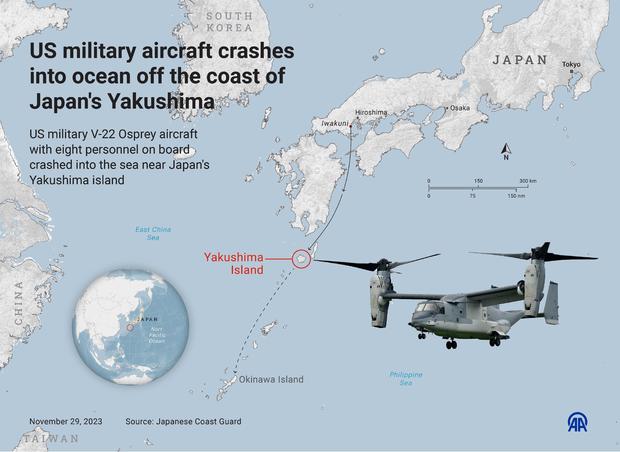U.S. military releases names of crew members who died in Osprey crash off coast of Japan
The U.S. military has released the names of all eight Air Force crew members on an Osprey aircraft that crashed into the sea on Nov. 29, as search and rescue operations transitioned into search and recovery operations off the shore of Yakushima Island, Japan.
The Osprey had been performing a routine training mission when it went down, according to the Air Force.
So far, the remains of three crew members have been recovered, according to a military news release, and the remains of another three have been located and are being recovered. Two Airmen have not yet been located, but the shift to search and recovery indicates the military no longer expects to find survivors.
Staff Sgt. Jake Galliher's remains were recovered on the day of the crash. He was the only one of the total eight crew members whose remains had been found before Monday. Galliher, 24, was a young father from Massachusetts who had been assigned to the 43rd Intelligence Squadron as a direct support operator.
The Air Force released the names and information about the other seven on Tuesday:
- Maj. Jeffrey T. Hoernemann, 32, of Andover, Minnesota, was a CV-22 instructor pilot and officer in charge of training, assigned to the 21st Special Operations Squadron, 353rd Special Operations Wing, Yokota Air Base, Japan.
- U.S. Air Force Maj. Eric V. Spendlove, 36, of St. George, Utah, was a residency trained flight surgeon and medical operations flight commander assigned to the 1st Special Operations Squadron, 353rd Special Operations Wing, Kadena Air Base, Japan.
- U.S. Air Force Maj. Luke A. Unrath, 34, of Riverside, California, was a CV-22 pilot and flight commander assigned to the 21st Special Operations Squadron, 353rd Special Operations Wing, Yokota Air Base, Japan.
- U.S. Air Force Capt. Terrell K. Brayman, 32, of Pittsford, New York, was a CV-22 pilot and flight commander assigned to the 21st Special Operations Squadron, 353rd Special Operations Wing, Yokota Air Base, Japan.
- U.S. Air Force Tech. Sgt. Zachary E. Lavoy, 33, of Oviedo, Florida, was a medical operations flight chief assigned to the 1st Special Operations Squadron, 353rd Special Operations Wing, Kadena Air Base, Japan.
- U.S. Air Force Staff Sgt. Jake M. Turnage, 25, of Kennesaw, Georgia, was a flight engineer assigned to the 21st Special Operations Squadron, 353rd Special Operations Wing, Yokota Air Base, Japan.
- U.S. Air Force Senior Airman Brian K. Johnson, 32, of Reynoldsburg, Ohio, was a flight engineer assigned to the 21st Special Operations Squadron, 353rd Special Operations Wing, Yokota Air Base, Japan.
"I am deeply saddened by the loss of eight American troops in a tragic aircraft crash off the coast of Japan," Defense Secretary Lloyd Austin said in a statement Tuesday.
Austin promised a rigorous investigation of the incident, adding, "The United States is grateful to Japan's Coast Guard, Self-Defense forces, and local communities – including fishermen – for their search and rescue efforts."
The service of the eight Airmen "will never be forgotten, as they are now among the giants who shape our history," Lt. General Tony Bauernfeind, Air Force Special Operations Command commander, said in a statement.
The Air Force said that all five U.S. military branches, along with Japanese allies, would continue the search and recovery operations.
"We are resolved to locating our aircrew and bringing them home to their families," said Rear Adm. Jeromy Williams, Special Operations Command - Pacific commander.
The search and rescue efforts included air, surface and subsurface searches of the water and coastlines in the vicinity of Yakushima, the U.S. military said. The Japan Coast Guard said it had deployed side-scan sonar to scour the seabed for evidence of the ill-fated Osprey.
Several pieces of debris believed to be from the aircraft were recovered from the water Wednesday, in addition to a large, empty orange life raft.
Japan had asked the U.S. to stop flying Ospreys over Japan until the aircraft could be confirmed safe. Chief Cabinet Secretary Hirokazu Matsuno told reporters Friday that Japan had made that request "officially" of Washington. He called the U.S. continued use of the aircraft in Japan "deeply regrettable," and said it had caused "great anxiety to people" in the area where the plane went down.
There has been a spate of fatal U.S. Osprey crashes in recent years, including during a multinational training exercise on an Australian island in August, which killed three U.S. Marines and left eight others hospitalized. All five U.S. Marines on board another Osprey died the previous summer when their aircraft crashed in the California desert.
The U.S. military's investigation found that "dual hard clutch engagement" leading to engine failure led to that crash. The U.S. Marine Corps and Navy have reported similar clutch slips in their Ospreys and said they have worked to address the issue, according to The Associated Press.
An Osprey crashed in shallow water just off the Japanese island of Okinawa in 2016, but all the U.S. Marines on board survived that incident.
Despite the crashes, the versatility of the Osprey — which can take off and land like a helicopter but then tilt its rotors to fly as a turbo-prop plane — has made it a trusty workhorse for the U.S. military, especially for troop transport.
Both the Japanese and U.S. militaries will likely want to be able to continue using them in the highly strategic corner of the western Pacific.
Japanese reporters said they had seen multiple U.S. Ospreys take off Thursday from Okinawa, where the U.S. has its biggest military base in the region, so there was no sign that the U.S. was acting on Japan's request for a grounding of the aircraft.
CBS News' Duarte Dias in London and Eleanor Watson in Washington D.C. contributed to this report.






